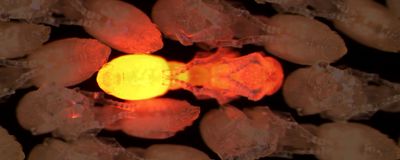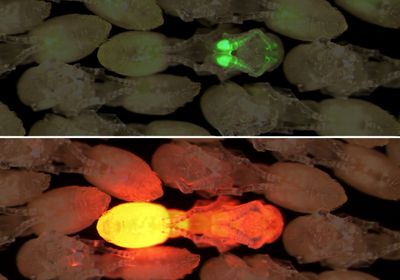ABOVE: In this transgenic ant pupa surrounded by wild type pupae, expression of red fluorescent protein shows throughout the ant pupa body. Taylor Hart
Ants rely heavily on their acute senses of smell to orchestrate social behaviors, including seeking food or defending their colonies. While the ant olfactory system is more complex than that of other insects, the understanding of how it works is still limited. By using transgenic ants where olfactory neurons light up when activated, researchers discovered a sensory center that receives the input from the alarm pheromones produced by other colony members when sensing danger. Their findings were published recently in Cell.1
See “The Genetics of Society”
“Ants have evolved all these different pheromones that they use to pass different kinds of information to one another, and we see signatures of this” in their brains, said Taylor Hart, a neurobiologist at the Rockefeller University and coauthor of the study. To detect these scent markers, ants use their antennae, from which sensory neurons connect to large brain structures known as the antennal lobes. These lobes are “subdivided anatomically into many ball-shaped structures that are called glomeruli,” explained Hart. There are approximately 500 glomeruli in each ant antennal lobe, but up until now, it was not clear how they activate in response to different odors.
“This is all very interesting to us because we want to know” how these brain structures work at a functional level and how the different pheromones that maintain ant societies are perceived and encoded within the ant brain, Hart said.
To explore these questions, Hart and her colleagues created transgenic ants, which is a milestone that has never been achieved before. By introducing a fluorescent marker that reports the calcium activity of olfactory sensory neurons in the clonal raider ant, Ooceraea biroi, the team monitored the neural activity in the animals’ antennal lobes. Then they exposed these transgenic ants to four different alarm pheromones and spied on their brains.
See “Ant Pupae Feed Adults, Larvae with Secreted Liquid”
The alarm pheromones activated one to six glomeruli, a handful of the approximately 500 found in the antennal lobe. The scientists also noticed a significant overlap among the glomeruli activated by each of the pheromones tested. For instance, three of these scents, specifically those inducing panic that results in nest evacuation, often activated the same glomerulus. When Hart and her colleagues mapped two other relevant glomeruli for this response, they found that all three were spatially clustered.
These observations suggest that these danger-signaling pheromones feed into a sensory hub rather than triggering a more spatially distributed activation of glomeruli. “We don’t know for sure that the sparse representation is true for all odors,” said Hart, but based on the brain response to some other scents they tested, “it could also be a general trend in this animal.”
Investigating these neurobiological questions in ants “opens up a lot of possibilities for understanding how these organisms use these chemical and social cues for manifesting all [of their] fascinating behaviors,” said Duke University insect neurobiologist Pelin Volkan, who was not involved in this study. She added that the transgenic ants developed by this research team will significantly contribute to that goal.
Figuring out the neuroscience fundamentals underlying these animals’ social interactions and how those behaviors emerge is going to be “super powerful,” Volkan concluded.
References
- Hart T, et al. Sparse and stereotyped encoding implicates a core glomerulus for ant alarm behavior. Cell. 2023; S0092-8674(23)00544-5.







